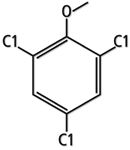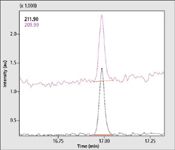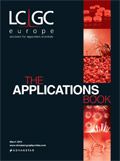High-Sensitivity Analysis of 2,4,6-trichloroanisole in Wine Using a Novel Headspace Sampler
Shimadzu Europa GmbH
Introduction
2,4,6-trichloroanisole (TCA) emitted from wine corks can taint wine and cause an objectionable odour. Because of the low threshold value for sensing the odour, highly sensitive measurements are required for monitoring. Conventionally, TCA has be measured using methods such as purge-and-trap, which is very effective in concentrating samples, or solid-phase microextraction (SPME) or thermal desorption analysis. The HS-20 headspace sampler with an incorporated trap function enables concentration of the headspace sample and ultimately highly sensitive analysis. The trap is filled with an adsorption material and is electronically cooled, thereby avoiding the need for coolant consumption. This application note describes an example of high-sensitivity measurement of TCA in wine using a HS-trap GC–MS system. The structure of TCA is illustrated in Figure 1 and the mass spectrum is shown in Figure 2.

Figure 1: Structure of 2,4,6-trichloroanisole (TCA).

Figure 2: Mass spectrum of TCA.
Equipment and Analytical Conditions
In this application the GCMS-QP2010 Ultra used was equipped with the novel technology of the HS-20 trap headspace sampler. Without any need for further preparation, the wine sample was placed in the headspace vials and analysed using the method parameters shown in Table 1. As a high concentration of ethanol is present in the wine sample, a trap temperature of 80 °C is used as a compromise to reduce the influence of ethanol in the results obtained.

Table 1: Analytical conditions.
Sensitivity
A wine sample spiked with the equivalent of 1 ng/L TCA was measured by selected ion monitoring (SIM) using the HS-trap method (Figure 3). The results clearly demonstrate the system power for analysis of very low concentrations of TCA with high sensitivity.

Figure 3: Selected ion monitoring (SIM) chromatogram of TCA in wine measured using HS-20Trap (wine spiked with 1 ng/L TCA).
A wine sample spiked with the equivalent of 100 ng/L TCA was measured by SIM using the headspace-GC–MS method and HS-trap method, as illustrated in Figures 4 and 5. A comparison of both shows that the HS-trap method provided about 10 times greater sensitivity.

Figure 4: SIM chromatogram of TCA in wine measured using conventional HS-20 GCâMS (wine spiked with 100 ng/L TCA).

Figure 5: SIM chromatogram of TCA in wine measured using HS-20Trap (wine spiked with 100 ng/L TCA).
Linearity and Repeatability
Linearity was confirmed by adding specific concentrations of TCA to wine (from 1–100 ng/L, see Figure 6). The calibration curve obtained with R2 = 0.9991 demonstrates the excellent linearity.

Figure 6: Linearity of TCA (wine spiked with 1â100 ng/L TCA).
3 ng/L of TCA was added to wine to test the repeatability (n = 5) of the peak area (Table 2). The results show good repeatability, with a coefficient of variation (CV) value not exceeding 5%.

Table 2: Area repeatability of TCA (n = 5, wine spiked with 3 ng/L TCA).
Conclusion
The application describes an example of high-sensitivity measurement of TCA in wine using a HS-trap GC–MS system. The results showed that the system was easily able to measure even a few nanograms per litre. This also confirmed that a HS-trap-GC–MS system using the HS-20 trap sampler is an effective and easy tool for monitoring of TCA in wine. The extremely low carry-over should be mentioned as an outstanding feature, based on the patent pending design of the sampler.

Shimadzu Europa GmbH
Albert-Hahn-Strasse 6-10 47269 Duisburg, Germany
tel. +49 203 7687 0 fax +49 203 766625
Email: shimadzu@shimadzu.eu
Website: www.shimadzu.eu

New Study Reviews Chromatography Methods for Flavonoid Analysis
April 21st 2025Flavonoids are widely used metabolites that carry out various functions in different industries, such as food and cosmetics. Detecting, separating, and quantifying them in fruit species can be a complicated process.
Analytical Challenges in Measuring Migration from Food Contact Materials
November 2nd 2015Food contact materials contain low molecular weight additives and processing aids which can migrate into foods leading to trace levels of contamination. Food safety is ensured through regulations, comprising compositional controls and migration limits, which present a significant analytical challenge to the food industry to ensure compliance and demonstrate due diligence. Of the various analytical approaches, LC-MS/MS has proved to be an essential tool in monitoring migration of target compounds into foods, and more sophisticated approaches such as LC-high resolution MS (Orbitrap) are being increasingly used for untargeted analysis to monitor non-intentionally added substances. This podcast will provide an overview to this area, illustrated with various applications showing current approaches being employed.

.png&w=3840&q=75)

.png&w=3840&q=75)



.png&w=3840&q=75)



.png&w=3840&q=75)








